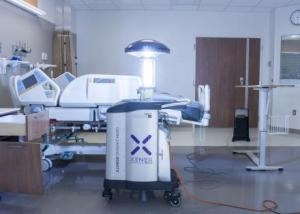Jan 11 2017
 A Xenex Germ-Zapping Robot pulses germicidial ultraviolet light to combat hospital-acquired infections. Credit: Michigan Medicine University of Michigan�
A Xenex Germ-Zapping Robot pulses germicidial ultraviolet light to combat hospital-acquired infections. Credit: Michigan Medicine University of Michigan�
A team of researchers headed by Keith S. Kaye, M.D., M.P.H., director of clinical research in the Michigan Medicine Division of Infectious Diseases, will test the performance of germ-zapping robots at Detroit hospitals.
This $2 million endeavor supported by the NIH’s Agency for Healthcare Research and Quality is the very first of its kind to study no-touch room disinfection.
Michigan researchers will analyze the ability of high intensity ultraviolet light delivered by Xenex Germ-Zapping Robots in order to protect patients from deadly superbugs, as Clostridium difficile, observed on surfaces.
Patients spread all across the country are vulnerable to hospital-acquired infections. They get these infections while staying at a medical facility. Considerable progress has been made in preventing a few types of infections, however they continue to be a major threat all over the world.
Kaye will collaborate with colleagues at Wayne State University and the Detroit Medical Center in order to conduct the study in two hospitals covering 16 total hospital units at the DMC.
A report will be presented by researchers at the end of two years highlighting rates of hospital-acquired infections in units where pulsed xenon UV light (PX-UV) was added to cleaning schedules compared to units where a sham UV disinfection system was added to conventional cleaning.
The researchers will measure if cleaning plus PX-UV decreased the number of infections from drug-resistant organisms that cause C.diff, Klebsiella pneumonia, vancomycinresistant enterococci (VRE), Escherichiae coli producing extended-spectrum betalactamases (ESBLs), Acinetobacter baumannii and methicillin-resistant Staphylococcus aureus (MRSA).
Hospital cleanliness has been recognized as an extremely significant process that will help to prevent hospital-acquired infections. This cleaning process deals with extensive cleaning and disinfection after a patient is discharged and before the admission of the next patient in the same room.
PX-UV lamps in the robot generate a flash of germicidal light in millisecond pulses, resulting in damaging of the cell structure and putting a stop to the DNA repair mechanisms for most pathogens.
The study’s unique design, which is double-blinded and sham-controlled, makes it the first research work examining the clinical impact of adding PX-UV to cleaning routines in hospitals.
Kaye is a professor of internal medicine at the University of Michigan. Prior to joining the faculty at Michigan Medicine, he worked as a professor in the Division of Infectious Diseases and Department of Medicine at Wayne State University and DMC.